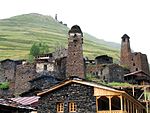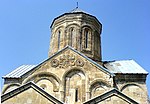Lista e vendeve të trashëgimisë botërore në Gjeorgji
Përmbajtja e UNESCO-s përfaqëson një organizatë edukative, shkencore dhe kulturore që është përgjegjëse për t'identifikuar dhe të ruajtë vendet e Trashëgimisë Botërore, të cilat janë të shquar për vlerën e tyre universale kulturore apo natyrore. Këto vendet janë nominuar nga shtetet e cilat kanë nënshkruar Konventën e Trashëgimisë Botërore të UNESCO-s, themeluar në vitin 1972.Trashëgimia kulturore përbënhet nga monumente (përmbajnë vepra arkitekturore, skulptura monumentale apo mbishkrime), grupe ndërtesash dhe vende (përmbajnë vendet arkeologjike). Vendet natyrore (përmbajnë formacione fizike dhe biologjike), formacionet gjeologjike dhe fiziko-geografike (përmbajnë habitatet e specieve të kercenuara të kafshëve dhe bimëve), dhe vendet natyrore që janë të rëndësishme nga pikapamja e shkencës, ruajtjes ose bukurisë natyrore, përkufizohen si trashëgimia natyrore. Gjeorgjia ratifikoi konventën më 4 nëntor 1992.
Shqip:
Deri më 2022, Gjeorgjia ka katër site në listën e Trashëgimisë Botërore dhe njëzet e katër në listën e pranishme. Dy sitet e parë që u inskruarën në listën e Trashëgimisë Botërore ishin Monumentet Historike të Mtskheta dhe siti i përfshirë kishën Bagrati dhe manastirit Gelati, në vitin 1994. Megjithatë, për shkak të ndryshimeve të mëdha në strukturën e saj të kërcënuar për integritetin e saj dhe autenticitetin, kisha Bagrati u shtua në Listën e Trashëgimisë Botërore në Peril në vitin 2010 dhe pastaj u dal nga lista e Trashëgimisë Botërore në vitin 2017. Svaneti i Epërmen u listua në vitin 1996 dhe siti më i fundit që u listua ishte Rezervatet e Rrainfertilave dhe Bregdetit Colchic, në vitin 2021. Ky fundi është i vetmi sit natyror i Gjeorgjis, ndërsa tre të tjerat janë të llojit kulturore.
Vende të Trashëgimisë Botërore[Redakto | Redakto nëpërmjet kodit]
UNESCO rendit vendet sipas dhjetë kritereve ; çdo hyrje duhet të plotësojë të paktën një nga kriteret. Kriteret i deri në vi janë kulturorë, dhe vii deri në x janë të natyrshëm. [1]
| Site | Image | Location | Year listed | UNESCO data | Description |
|---|---|---|---|---|---|
| Historical Monuments of Mtskheta | 
|
Mtskheta-Mtianeti | 1994 | 708; iii, iv (cultural) | Mtskheta was the capital of Georgia from the 3rd century BCE to the 5th century CE, and is still the centre of the Georgian Orthodox Church. It was the place where Christianity was proclaimed as the official religion of Georgia in 337. The Jvari Monastery (pictured) dates to the 6th century while the Svetitskhoveli Cathedral and the Samtavro Monastery were built in the 11th century upon the site of earlier churches. The monuments represent different stages in the development of medieval religious architecture in the region.[2] |
| Gelati Monastery | 
|
Imereti | 1994 | 710; iv (cultural) | Gelati Monastery, a masterpiece of the Georgian Golden Age, was built in 1106 by King David IV and was one of the main cultural and intellectual centres in Georgia throughout the Middle Ages. It had an Academy which employed some of the most celebrated Georgian scientists, theologians, and philosophers, many of whom had previously been active at various orthodox monasteries abroad, such as from the Mangan Academy in Constantinople. At the time of inscription, the World Heritage Site also included the Bagrati Cathedral. Between 2010 and 2017, it was listed as endangered due to the cathedral undergoing major reconstruction detrimental to its integrity and authenticity. In 2017, Bagrati Cathedral was removed from the World Heritage property and Gelati Monastery was delisted from the endangered list.[3][4] |
| Upper Svaneti | 
|
Samegrelo-Zemo Svaneti | 1996 | 709; iv, v (cultural) | Upper Svaneti is a valley along the Enguri river between the Caucasus and the Svaneti Range. The Svan communities adapted to the life in mountain regions. The most prominent architectural feature of the villages are the medieval stone towers which had both defensive and residential functions. More than 200 towers and houses have been preserved in the village of Chazhashi.[5] |
| Colchic Rainforests and Wetlands | 
|
Samegrelo-Zemo Svaneti, Guria, Adjara | 2021 | 1616; ix, x (natural) | The coastal region of Georgia (the historical Colchis) is covered by wetlands, forests, peat bogs, lakes, and sandy dunes. Some areas are protected as Ramsar sites. They are important biodiversity spots and serve as a stop on the migration routes of birds such as the black stork, common crane, and great egret. The World Heritage Site comprises seven properties: Kintrishi-Mtirala and Ispani in Adjara, Grigoleti and Imnati in Guria, and Pitshora, Nabada, and Churia in Samegrelo-Zemo Svaneti. They are administered in Georgia as parts of the Kolkheti National Park (pictured), Kintrishi Strict Nature Reserve, Kobuleti Protected Areas, and Mtirala National Park.[6][7] |
Lista tentative[Redakto | Redakto nëpërmjet kodit]
Në lidhje me sitet e Trashëgimisë Botërore, shtetet anëtare mund të krijojnë një listë të pranishme të sitet që mund të përfshijnë për nominim. Nominimet për Listën e Trashëgimisë Botërore nuk pranohen nëse sito nuk ishte para më parë në listën e pranishme. Deri më 2020, Gjeorgjia konservon njëzet e katër objekte në listën e pranishme të saj.
| Site | Image | Location | Year listed | UNESCO criteria | Description |
|---|---|---|---|---|---|
| Alaverdi Cathedral | 
|
Kakheti | 2007 | iv, vi (cultural) | The cathedral was built in the first half of the 11th century on the site of a monastery dating to the 6th century. With a height of 50 metres (160 ft), it is the tallest cathedral in Georgia, and has a very spacious interior. The complex is surrounded by a fortified wall.[8] |
| Ananuri | 
|
Mtskheta-Mtianeti | 2007 | iii (cultural) | The Ananuri castle complex, built in the 17th century, is located along the Georgian Military Road. It comprises several churches with fine wall paintings and wall reliefs. The Church of the Virgin is the burial place of the eristavis (Dukes) of Aragvi.[9] |
| David Gareji Monasteries and Hermitage | 
|
Kakheti | 2007 | i, ii, iii, iv, v, vi, vii, x (mixed) | The Georgian Orthodox monastery complex comprises 19 medieval monasteries with about 5000 cells for monks. The first monasteries were founded in the 6th century by St. David Garejeli, one of the Thirteen Assyrian Fathers who came to Georgia. The monasteries saw a golden age between the 10th and the 13th centuries, declined following the Mongol invasions, and saw a revival on a smaller scale in the 17th and 18th centuries. Murals from different periods have been preserved in churches. Remains from Bronze and Iron Age settlements have been found in the area as well.[10] |
| Dmanisi Hominid Archaeological Site | 
|
Kvemo Kartli | 2007 | iii, v (cultural) | The hominid remains found at Dmanisi belong to some of the earliest hominid fossils outside Africa. The excavations have been ongoing since 1983. Several skulls, teeth, post-cranial remains, as well as stone artefacts and animal remains have been found at the site. They were dated to 1.75 million years ago and represent an important stage in human evolution.[11] |
| Gremi Church of Archangels and Royal Tower | 
|
Kakheti | 2007 | ii, iii (cultural) | Gremi, a city on the Silk Road, was the capital of the Kingdom of Kakheti until it was destroyed by the Safavid Shah Abbas in the 17th century and left in ruins. The Church of the Archangels was commissioned in 1565 by King Levan and represents an evolution of Georgian ecclesiastic architecture. A three-storey tower with a belfry on top is located next to the church.[12] |
| Kvetera Church | 
|
Kakheti | 2007 | iii, iv (cultural) | Kvetera Church was built in the 10th century within a fortress complex. Architecturally, it is a derivative of the Jvari Church in Mtskheta. It is a small church with a plan that is a four-apse cross with four niches between apses.[13] |
| Mta-Tusheti | 
|
Kakheti | 2007 | iv, v, vii, x (mixed) | Mta-Tusheti is a region on the slopes of the Caucasus mountains. The habitats up the slopes of the mountains change from forests to high meadows to the subnivean zone, and each is home to a variety of animals and plants. The vernacular architecture of the region is characterized by fortress-like buildings, similar to those in Svaneti.[14] |
| Nikortsminda Cathedral | 
|
Racha | 2007 | ii, iv (cultural) | The Nikortsminda Cathedral, one of the most important medieval monuments in Georgia, was constructed in the early 11th century during the reign of King Bagrat III. The church has a hexagonal plan and is decorated with reliefs depicting religious themes. The interior is decorated with paintings from the 16th and 17th centuries.[15] |
| Samtavisi Cathedral | 
|
Shida Kartli | 2007 | iv (cultural) | The Samtavisi Cathedral was built in 1030 and saw a major renovation in the 15th century, including rebuilding the dome and the western wall. In view of the architectural development, the cathedral introduced a new style of decoration, with a large ornamental cross on the eastern facade and a lozenge pattern. Fragments of the 17th century frescos remain in the interior.[16] |
| Shatili | 
|
Mtskheta-Mtianeti | 2007 | v (cultural) | Shatili is a mountain village at an elevation of 1,400 metres (4,600 ft), located in the Argun River gorge. The village is a fortress complex, with buildings serving both in residential and defence functions. The village dates to the late medieval and early modern period.[17] |
| Tbilisi Historic District | 
|
Tbilisi | 2007 | ii, iii, iv, v, vi (cultural) | Tbilisi, the capital of Georgia, was an important city on the Silk Road and a major centre in the Caucasus region. It was founded in the 5th century CE and was marked by influences of different cultures. The city is located on the banks of the Mtkvari River and is overlooked by the Narikala Fortress. Typical features of Tbilisi are balconies and courtyards of residential houses.[18] |
| Uplistsikhe Cave Town | 
|
Shida Kartli | 2007 | ii, iii, iv, v (cultural) | First traces of human occupation at Uplistsikhe date to the 2nd millennium BCE. It was an important centre during the Hellenistic period and late antiquity, reached another heyday from the 9th to 11th centuries, and was ultimately ravaged during the Mongol raids in the 13th century. The town is cut in rock, including a palace complex and a three-nave basilica from the 6th century. Some caves have complex decorations.[19] |
| Vani | 
|
Imereti | 2007 | ii, iii, vi (cultural) | Vani was an ancient city in the historic region of Colchis that was inhabited from the 7th to the 1st century BCE. It was a political and religious centre of the area. In the Hellenistic period, the city saw a significant influence of Greek culture, in view of architecture, jewellery, and burial customs. The archaeological excavations uncovered a large number of artefacts that are now on display at the Georgian National Museum in Tbilisi.[20] |
| Vardzia-Khertvisi | 
|
Samtskhe–Javakheti | 2007 | ii, iii, iv, v, vi, vii (mixed) | This nomination comprises the gorge of the Mtkvari River in the length of 18 kilometres (11 mi) between the Khertvisi Fortress and the rock monastery in Vardzia that was constructed in the 12th and 13th centuries. Human settlements have been adapted to the layout of the landscape.[21] |
Shiko gjithashtu[Redakto | Redakto nëpërmjet kodit]
Referime[Redakto | Redakto nëpërmjet kodit]
- ^ "UNESCO World Heritage Centre – The Criteria for Selection". UNESCO World Heritage Centre. Arkivuar nga origjinali më 12 qershor 2016. Marrë më 17 gusht 2018.
{{cite web}}: Mungon ose është bosh parametri|language=(Ndihmë!) - ^ "Historical Monuments of Mtskheta". UNESCO World Heritage Centre. Arkivuar nga origjinali më 8 dhjetor 2005. Marrë më 26 mars 2021.
{{cite web}}: Mungon ose është bosh parametri|language=(Ndihmë!) - ^ "Gelati Monastery, Georgia, removed from UNESCO's List of World Heritage in Danger". UNESCO World Heritage Centre. Arkivuar nga origjinali më 15 korrik 2017. Marrë më 23 prill 2018.
{{cite web}}: Mungon ose është bosh parametri|language=(Ndihmë!) - ^ "Gelati Monastery". UNESCO World Heritage Centre. Arkivuar nga origjinali më 3 gusht 2005. Marrë më 26 mars 2021.
{{cite web}}: Mungon ose është bosh parametri|language=(Ndihmë!) - ^ "Upper Svaneti". UNESCO World Heritage Centre. Arkivuar nga origjinali më 23 mars 2021. Marrë më 26 mars 2021.
{{cite web}}: Mungon ose është bosh parametri|language=(Ndihmë!)Mirëmbajtja CS1: Datë e përkthyer automatikisht (lidhja) - ^ "Colchis Wetlands and Forests". UNESCO World Heritage Centre. Arkivuar nga origjinali më 26 korrik 2021. Marrë më 5 gusht 2021.
{{cite web}}: Mungon ose është bosh parametri|language=(Ndihmë!) - ^ "Georgia's Colchic Rainforests, Wetlands Granted World Heritage Status". Civil Georgia. 27 korrik 2021. Arkivuar nga origjinali më 28 korrik 2021. Marrë më 31 korrik 2021.
{{cite news}}: Mungon ose është bosh parametri|language=(Ndihmë!)Mirëmbajtja CS1: Datë e përkthyer automatikisht (lidhja) - ^ "Alaverdi Cathedral". UNESCO World Heritage Centre. Arkivuar nga origjinali më 10 korrik 2019. Marrë më 3 prill 2021.
{{cite web}}: Mungon ose është bosh parametri|language=(Ndihmë!) - ^ "Ananuri". UNESCO World Heritage Centre. Arkivuar nga origjinali më 15 gusht 2020. Marrë më 3 prill 2021.
{{cite web}}: Mungon ose është bosh parametri|language=(Ndihmë!) - ^ "David Gareji Monasteries and Hermitage". UNESCO World Heritage Centre. Arkivuar nga origjinali më 11 nëntor 2020. Marrë më 3 prill 2021.
{{cite web}}: Mungon ose është bosh parametri|language=(Ndihmë!) - ^ "Dmanisi Hominid Archaeological Site". UNESCO World Heritage Centre. Arkivuar nga origjinali më 3 gusht 2019. Marrë më 3 prill 2021.
{{cite web}}: Mungon ose është bosh parametri|language=(Ndihmë!) - ^ "Gremi Church of Archangels and Royal Tower". UNESCO World Heritage Centre. Arkivuar nga origjinali më 7 gusht 2020. Marrë më 3 prill 2021.
{{cite web}}: Mungon ose është bosh parametri|language=(Ndihmë!) - ^ "Kvetera Church". UNESCO World Heritage Centre. Arkivuar nga origjinali më 5 gusht 2020. Marrë më 3 prill 2021.
{{cite web}}: Mungon ose është bosh parametri|language=(Ndihmë!) - ^ "Mta-Tusheti". UNESCO World Heritage Centre. Arkivuar nga origjinali më 30 tetor 2020. Marrë më 6 prill 2021.
{{cite web}}: Mungon ose është bosh parametri|language=(Ndihmë!) - ^ "Nicortsminda Cathedral". UNESCO World Heritage Centre. Arkivuar nga origjinali më 11 gusht 2020. Marrë më 6 prill 2021.
{{cite web}}: Mungon ose është bosh parametri|language=(Ndihmë!) - ^ "Samtavisi Cathedral". UNESCO World Heritage Centre. Arkivuar nga origjinali më 23 qershor 2020. Marrë më 6 prill 2021.
{{cite web}}: Mungon ose është bosh parametri|language=(Ndihmë!) - ^ "Shatili". UNESCO World Heritage Centre. Arkivuar nga origjinali më 28 janar 2021. Marrë më 6 prill 2021.
{{cite web}}: Mungon ose është bosh parametri|language=(Ndihmë!) - ^ "Tbilisi Historic District". UNESCO World Heritage Centre. Arkivuar nga origjinali më 24 shtator 2020. Marrë më 6 prill 2021.
{{cite web}}: Mungon ose është bosh parametri|language=(Ndihmë!) - ^ "Uplistsikhe Cave Town". UNESCO World Heritage Centre. Arkivuar nga origjinali më 26 prill 2021. Marrë më 6 prill 2021.
{{cite web}}: Mungon ose është bosh parametri|language=(Ndihmë!)Mirëmbajtja CS1: Datë e përkthyer automatikisht (lidhja) - ^ "Vani". UNESCO World Heritage Centre. Arkivuar nga origjinali më 13 prill 2021. Marrë më 6 prill 2021.
{{cite web}}: Mungon ose është bosh parametri|language=(Ndihmë!)Mirëmbajtja CS1: Datë e përkthyer automatikisht (lidhja) - ^ "Vardzia-Khertvisi". UNESCO World Heritage Centre. Arkivuar nga origjinali më 13 prill 2021. Marrë më 6 prill 2021.
{{cite web}}: Mungon ose është bosh parametri|language=(Ndihmë!)Mirëmbajtja CS1: Datë e përkthyer automatikisht (lidhja)

